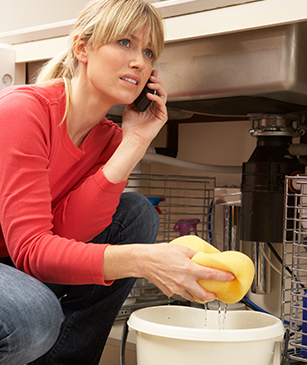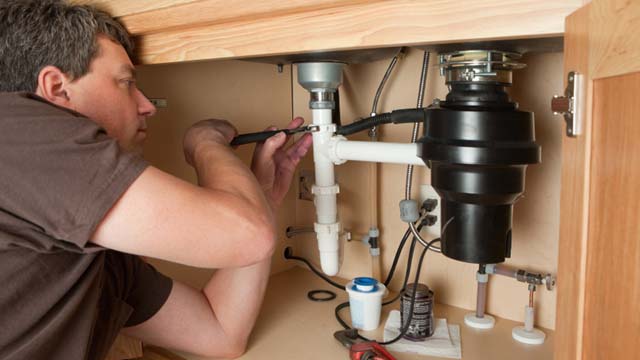Easy-to-Follow Techniques for Repairing a Leaky Garbage Disposal
Easy-to-Follow Techniques for Repairing a Leaky Garbage Disposal
Blog Article
This post down below pertaining to The Handy Guide To Fixing Your Garbage Disposal Leaking is exceptionally motivating. Don't miss out on it.

Waste disposal unit are vital kitchen home appliances that help in taking care of food waste successfully. Nevertheless, a dripping garbage disposal can be a discouraging and unpleasant problem to take care of. Fortunately, numerous leakages can be dealt with easily with a couple of simple steps. In this post, we will certainly review just how to repair a dripping waste disposal unit properly.
Intro
Garbage disposals are installed under kitchen sinks and are created to shred food waste right into smaller sized pieces, permitting it to pass through the plumbing system easily. While these devices are typically trustworthy, leakages can occur over time due to damage, loosened connections, or damage to the device.
Step-by-Step Overview to Taking Care Of a Leaking Garbage Disposal
Switch off the Power
Before trying any kind of repair services, guarantee that the power to the waste disposal unit system is turned off to stop the risk of electrical shock.
Locate the Leakage
Identify the precise place of the leakage and identify the reason
Tighten Links
Make use of a wrench to tighten any kind of loosened connections in between the disposal device and the plumbing system.
Replace Seals or Gaskets
If the leak results from used seals or gaskets, remove the old components and change them with brand-new ones.
Patching Fractures or Holes
For fractures or openings in the disposal device, use epoxy or an appropriate patching product to seal the damaged area.
Determining the Source of the Leakage
Before trying to fix a leaking garbage disposal, it is necessary to determine the resource of the leakage. This can typically be done through aesthetic examination or by performing easy examinations.
Visual Inspection
Inspect the garbage disposal device meticulously for any kind of indications of water leakage. Pay close attention to locations around seals, gaskets, and connection factors.
Evaluating for Leakages
One method to test for leakages is by running water via the disposal system and looking for any type of noticeable indications of leak.
Common Causes of Leaks in Trash Disposals
Worn Seals and Gaskets
Seals and gaskets play a vital function in stopping water from leaking out of the waste disposal unit. With time, these elements can deteriorate, resulting in leakages around the disposal unit.
Loose Connections
The links in between the garbage disposal and the plumbing system can come to be loose with time, creating water to leak out throughout procedure.
Cracks or Openings in the Disposal System
Physical damage to the waste disposal unit, such as cracks or openings in the housing, can likewise lead to leaks.
Devices and Products Needed for Fixing a Dripping Garbage Disposal
Prior to beginning the repair work process, gather the required tools and materials, including a screwdriver, flexible wrench, plumbing's putty, substitute seals or gaskets, and epoxy or patching product for fixing fractures or openings.
Examining the Waste Disposal Unit After Fixing
Once the repair work is full, check the waste disposal unit by running water with it to make sure that the leakage has been fixed.
Preventive Maintenance Tips to Stay Clear Of Future Leaks
To avoid future leaks, it is necessary to perform normal maintenance on your waste disposal unit. This includes keeping it clean, staying clear of placing non-food items or tough objects down the disposal, and periodically checking for leakages or other concerns.
Conclusion
In conclusion, taking care of a dripping garbage disposal is a reasonably uncomplicated procedure that can be finished with basic devices and materials. By complying with the actions laid out in this write-up and exercising precautionary upkeep, you can maintain your garbage disposal in good working problem and stay clear of costly repairs in the future.
HERE’S HOW TO FIX YOUR GARBAGE DISPOSAL
WHAT TO DO IF SOMETHING IS STUCK IN YOUR GARBAGE DISPOSAL
If the impeller won’t turn, there’s probably something stuck in the disposal. It could be a steak bone or peach pit, although plumbers report pulling all sorts of inappropriate objects out of disposals, such as bottle caps or aluminum foil. Make sure power to the disposal is off, and look inside to see if you can see the source of the jam.
Never stick your fingers in a disposal. Pull out anything you see with tongs or pliers.
If the disposal still won’t work, it may be time to call a plumber or consider buying a new disposal. GEM Plumbing & Heating is here for all of your garbage disposal needs.
WHAT TO DO IF YOUR GARBAGE DISPOSAL DRAIN IS CLOGGED
Take everything out from underneath your sink and put a bucket or other container under your disposal to catch any water that drains out. Disconnect your disposal from the power supply. If it’s plugged into a wall outlet, unplug it. If it’s hardwired into an electrical box, go to the electrical panel and turn off the breaker for the disposal. Pour ¼ cup of baking soda into the drain, followed by ½ cup of white vinegar. Give the solution a few minutes to fizz and do its work. Look into the disposal with a flashlight to see if you can see an object that might be causing the clog. If you see it, remove it using tongs or pliers. MORE TIPS ON DEALING WITH A CLOGGED GARBAGE DISPOSAL
Never use drain cleaner in a garbage disposal. It can damage the plastic parts inside the disposal. You can also be splashed with the caustic liquid while working to clear the clog. Beware! Never stick your fingers into a garbage disposal. Trust us — not a good idea. In many instances, your dishwasher drains through your garbage disposal. This allows the disposal to grind any large food particles that may be drained out of your dishwasher. There are some jurisdictions, however, where the plumbing code prohibits such a connection. WHAT TO DO WHEN YOUR DISHWASHER DRAINS THROUGH THE DISPOSAL
Run some water in the sink so your plunger has at least a ½-inch of water to create a seal and plunge vigorously up and down several times. You may need to repeat this several times. Run hot water down the drain to clear any residue that remains.

As a person who reads about Why Is , I assumed sharing that information was sensible. Sharing is caring. Helping others is fun. We recognize the value of reading our article about Why Is My Garbage Disposal Leaking From the Bottom?.
Call Today Report this page